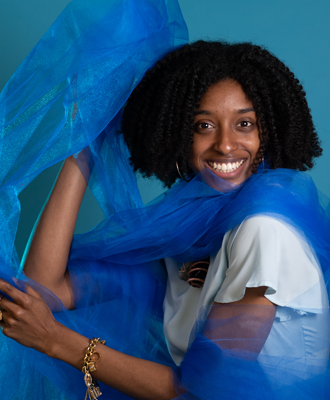Fashion Forward
The Department of Art ushers in a newly revamped fashion design and fashion merchandising program unlike anything else in the region
By Casey Hilder

With the incorporation of a new and expanded Fashion Design and Fashion Merchandising program joining the Department of Art, CCFA students have yet another way to express themselves of Art, CCFA students have yet another way to express themselves.
“We are absolutely thrilled to take on this high-quality program that has already established such incredible connections to the fashion industry in Memphis under the leadership of Sonin Lee,” says CCFA dean Anne Hogan. “It feels like the natural home. Looking ahead, there’s so much potential synergy for interesting interdisciplinary work for all of our programs across the College of Communication and Fine Arts.”
The University of Memphis is the only public institution in the state and the only university in the region to oƒer a Fashion Design and Fashion Merchandising concentrations within the BA Art degree. The BA fashion curriculum consists of a 15-hour art core and a 24-hour art focus. The program is built around Visual Arts, Fashion Design, Fashion Merchandising and Global Art Histories concentrations.
When the Department of Art was presented with the opportunity to acquire the Fashion Design and Fashion Merchandising program from the College of Professional & Liberal Studies, the outcome was obvious for all involved.
“We were asked if our department was interested and I immediately said yes,” says Richard Lou, chair of the Department of Art. “What was there to think about? Fashion Design is yet another articulation of the art world and how people express themselves. Of course, this is a home for them.
Lou credits Hogan for arranging a meeting between Department of Art representatives
and Richard Irwin, dean of the College of Professional & Liberal Studies. The new
BA degree from the Department of Art allowed for the transference of Fashion Design
and Fashion Merchandising students from the College of Professional & Liberal Studies
to the College of Communication and Fine Arts, in essence applying the appropriate
nationally recognized art degree and more visibility to an expanding program. The
program graduated its first crop of students under the banner of the Department
of Art in the spring of 2021.
“We’re still in the process of transitioning, but the faculty and I are very excited,” Lou says. “Once we completely integrate the fashion design program, you’ll see fashion students walking around the building, sharing their work with the rest of the creative community within the department.”
Lee, clinical associate professor and program coordinator with the Department of Art, is credited as the person behind the move and was tasked with expanding and modernizing the program in its new home. Lee previously taught fashion merchandising and design courses in Los Angeles for more than 15 years.
“There’s a difference between a professional degree and a fine arts degree, and fashion is one of those areas that could really be seen as either one,” says Lee. “At the end of the day, it just made sense that the fashion program ended up in the Department of Art where it would thrive.”
Lee, who moved to Memphis from Los Angeles five years ago to take the job as a professor of fashion merchandising, was no stranger to both the fashion program and the Department of Art. She fit in right away as things took shape.
“When I got the job, I immediately started rewriting the whole fashion merchandising
program,” she says. “It was so clear from the
start that this was something that Memphis wanted and needed.”
As part of the effort to modernize the preexisting fashion courses, Lee brought in
new software and focused classes around things like editorial photo shoots and consumer
engagement in the digital era.
Lucas Charles, an associate professor of graphic design with the Department of Art,
shepherded the process of transitioning the existing fashion curriculum to its new
home, accounting for things like budget, personnel and equipment availability.
“For us, it was a whole group of students that we believed we could really support,”
Charles says. “We took the time and looked at it from an accreditation and national
standards approach to create an appropriate degree option that fits the nature of
the practice. It has also helped us to build a strong BA program in the department,
which didn’t exist before the integration of fashion.”
As a result of this new program, the Department of Art expects an increased enrollment
of more than 25% over the next two years. Lee, Lou, Charles and others are currently
looking
at the department’s available space to physically integrate the new program into a
department that is quickly growing.
“It’s a good problem to have,” Lou says. “One that will require some reimagining of
the space within the Department of Art
and college as a whole, but we are up for it.”
For students like Colin Chapman, a junior fashion merchandising major, the presence of a strong fashion program presents a huge draw for enrollment. “As a Memphian, a lot of us try to attend school somewhere outside the city, but at the last minute — literally one week before school started — I transferred to Memphis and enrolled in my first fashion class in the fall of 2019,” he says. “I loved it, I loved how interactive it was, how the teachers brought in people from the field and how active all the instructors are in the industry. It has become my favorite thing ever.”
Chapman studies fashion merchandising, which means his coursework focuses on the business end of things as well as behavioral aspects of clothing.
Brooke Ballard, an adjunct professor with the Department of Art, teaches merchandise buying with knowledge drawn from her own 10-plus years of experience in the retail field. Ballard graduated from the program in 2018 and began teaching in January of 2020.
“When I found out we were moving to the Department of Art, I was so excited,” she says. “The students already see themselves as artists, and I believe this transition will help our program grow even more.”
Although a nascent program in the Department of Art, Lee and co., have already formed crucial community partnerships with the likes of Abby Phillips, head of Arrow Creative, as well as Memphis Fashion Week. In addition, Lee serves as liaison for Memphis Fashion Week’s Emerging Memphis Designer Project, which helps bring the work of new local designers to a larger audience.
“Our local partnerships have helped the community really learn about our program by
getting our name out there,” she says. “I even have a couple
of students now in the program who started as emerging designers.”
With a growing local buzz, Lee hopes to raise visibility for the program through more community partnerships and local collaborations in the future.
“That speaks tremendously to Sonin’s charisma, she is a dynamic person,” says Lou. “It’s really to her credit that she has plugged into our community so quickly.”
Fashion design students are tasked with learning things like pattern drafting, textiles, basic industry sewing and computer-aided design. For students like Bobbye Scurlock, senior fashion design major, that means cultivating a distinct personal style and finding ways to showcase work in any way possible.
“I love fashion, clothes and styling different looks,” says Scurlock, whose own personal style can run the gamut from streetwear to Met Gala-inspired ensembles.
Another student, senior studio art major Vince Long, returned to UofM after a 10-year absence when he learned of the new program.
“I knew I wanted to go back to school and I was going through the list of possibilities knowing that I wanted to maintain my existing art background,” says Long. “My first time around, the fashion program didn’t exist, so I knew that was something diƒerent that I really wanted to pursue. I chose the fashion design program because I wanted to stay in the art world, and this is a very utilitarian aspect of that world that really appeals to my brain.”
Long works on campus as manager of the fashion lab located at 400D Manning Hall. His fashion design goal is to create his own brand of sneakers while crafting his own line of sustainable, environmentally friendly apparel.
“Since joining the program, sustainability has been a big part of absolutely everything I do," he says. “At the end of the day, I want to see more clothing out there that is comfortable and doesn’t kill the planet.”
Both Scurlock and Long wear their curriculum influence on their sleeve in the form of custom-embroidered clothing of their own creation.
“This program is incredibly important for us because we’re tapping into the talent that’s already here locally, not in New York or California,” Lou says. “This area might one day become a central hub for fashion thinking and conceptualizing in the Mid-South. You see it going on all over the world: culture making has become decentralized, and now artists have the ability to make anything from anywhere as long as they have internet access which grants them the ability to jump into that global market.”
Faculty members behind the new program hope to see crossover among a wide variety of art majors thanks to the potential to take fashion courses as electives.
“It just seems like we have a chance to all help one another,” says Lee. “For example, we offer textile courses and many sculpture students already work with textiles and soft sculpture. They certainly can come over and take our textile courses to better understand the properties of diƒerent textiles. The same goes for diƒerent branches of graphic design and photography.”
There are several Fashion Merchandising courses that would also benefit these students. At the same time, Lee points out that many of the technical-minded fashion program students could benefit from branching out into diƒerent disciplines, hoping to see synergy among different practices like sculpture, photography and even art history.
“Conversely, some of the fashion students are interested in more avante-garde and wearable art,” says Lee. “Fashion students are more avant-garde, so I’d imagine that sculpture component really appeals to them, as well.”
While the establishment of a BA in contrast to its many BFA-centric degrees was a
big draw for the Department of Art, Charles sees the integration of fashion as a great
place to kickstart a number of new
and compelling design disciplines.
“I think the department is really looking to expand in a lot of ways at the moment and fashion is a great place to start,” he says. “It will be interesting to see what that kind of dynamic can create now that we have a whole other facet of design and art understanding in our department. There’s interest in all these different areas, and the presence of fashion makes it so much easier for students to move in and out of these disciplines while navigating their core coursework.”
Upcoming plans for the Fashion Design and Fashion Merchandising program include a spring museum exhibit at the Art Museum of the University of Memphis featuring a wearable art show that will be open to all students, not just fashion majors.

